 M.2 PCIe NVMe SSDs are all the rage on the consumer side of the market. These drives tend to pack a performance punch, take up a tiny amount of space (ideal for the notebook market that gets thinner and thinner each year), and more recently can bring more than enough capacity for consumer needs. WD, not wanting to be left behind, has introduced their M.2 PCIe NVMe SSD as part of their well received “Black” line of products. Like all M.2 NVMe SSDs, WD touts that their drive will deliver superior performance in a small form factor. The Black PCIe comes in both 256GB and 512GB capacities.
M.2 PCIe NVMe SSDs are all the rage on the consumer side of the market. These drives tend to pack a performance punch, take up a tiny amount of space (ideal for the notebook market that gets thinner and thinner each year), and more recently can bring more than enough capacity for consumer needs. WD, not wanting to be left behind, has introduced their M.2 PCIe NVMe SSD as part of their well received “Black” line of products. Like all M.2 NVMe SSDs, WD touts that their drive will deliver superior performance in a small form factor. The Black PCIe comes in both 256GB and 512GB capacities.
M.2 PCIe NVMe SSDs are all the rage on the consumer side of the market. These drives tend to pack a performance punch, take up a tiny amount of space (ideal for the notebook market that gets thinner and thinner each year), and more recently can bring more than enough capacity for consumer needs. WD, not wanting to be left behind, has introduced their M.2 PCIe NVMe SSD as part of their well received “Black” line of products. Like all M.2 NVMe SSDs, WD touts that their drive will deliver superior performance in a small form factor. The Black PCIe comes in both 256GB and 512GB capacities.
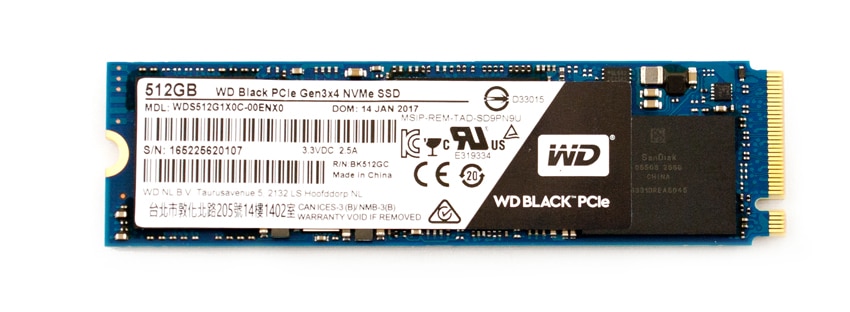
Aside from the typical performance benefits, which NVMe adds over SATA devices and the footprint benefits one gains with an M.2 over a 2.5” drive, the WD Black PCIe SSD has been F.I.T. Lab certified meaning that the drive has a wide compatibility with various PCs. The Black PCIe also comes with WD’s SSD Dashboard enabling users to monitor the health of the drive and Acronis True Image that allows drives to be easily cloned.
The WD Black PCIe SSD comes with a 5-year limited warranty and starts at $110 for the 256GB.
WD Black PCIe SSD specifications:
- Form factor: M.2 2280
- Interface: PCIe Gen3 8 Gb/s, up to 4 lanes
- Capacities: 256GB | 512GB
- Performance
- PCMark: 180K
- Sequential Read (Q=32, T=1): 2,050MB/s
- Sequential Write (Q=32, T=1): 700MB/s | 800MB/s
- Random Read 4 KB (Q=32, T=4): 170K IOPS
- Random Write 4 KB (Q=32, T=4): 130K IOPS | 134K IOPS
- Endurance (TBW): 80TB | 160TB
- Power
- Average Active: 135mW
- Supply voltage: 3.3 V ± 5%
- Peak power: 2.5A (10us)
- MTTF: 1.75M
- Environmental
- Operating Temperatures: 32°F to 158°F (0°C to 70°C)
- Non-operating Temperatures: -67°F to 185°F (-55°C to 85°C)
- Operating Vibration: 5.0 gRMS, 10–2000 Hz, 3 axes
- Non-operating Vibration: 4.9 gRMS, 7–800 Hz, 3 axes
- Operating/Non-Operating Shock 1,500G @ 0.5ms half sine sine
- Certifications FCC, UL, TUV, KC, BSM
- Weight: 7.2g
Design and Build
The WD Black PCIe SSD is an M.2 form factor drive making it roughly the size of a stick of gum. The top of the drive houses the controller, DRAM, and NAND packs covered by a sticker with product information and branding.
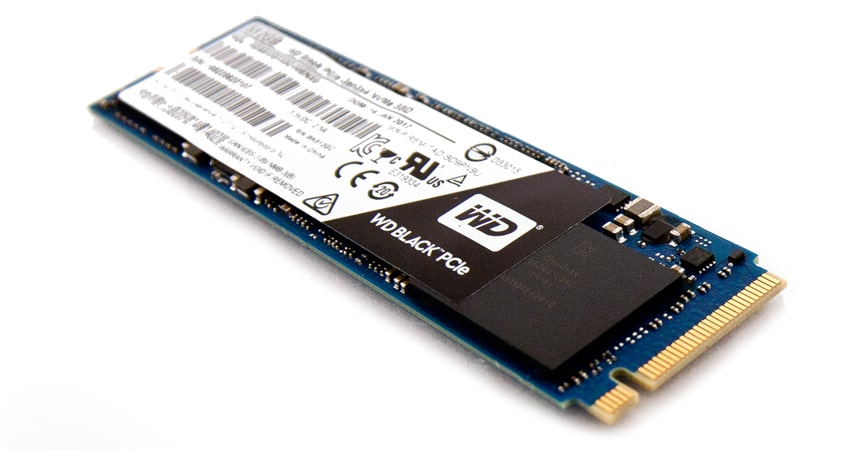
The other side of the SSD is blank since the drive is single sided.
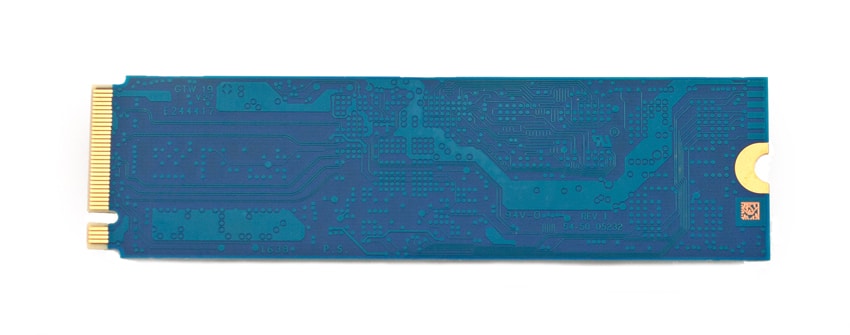
Consumer Synthetic Benchmarks
All consumer SSD benchmarks are conducted with the StorageReview HP Z640 Workstation. We compared the WD Black PCIe SSD to the following drives:
- Samsung 960 EVO NVMe M.2 SSD
- Samsung 960 Pro NVMe M.2 SSD
- Samsung SM951-NVMe M.2 SSD
- Samsung SM951 PCIe M.2 SSD
- Samsung 850 EVO M.2 SSD
- Samsung 950 Pro M.2 SSD
- OCZ RD400 m.2 NVMe 512GB
All IOMeter figures are represented as binary figures for MB/s speeds.
In our 2MB sequential benchmark, the WD Black hit 1.51GB/s read ad 763.8MB/s write putting it behind the other NVMe drives but ahead of the SATA drives.
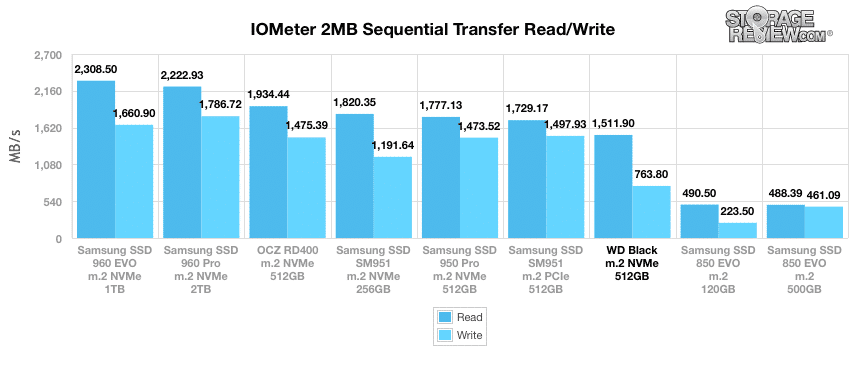
With 2MB random transfers, the WD Black gave us speeds of 1.12GB/s read and 385.74MB/s write. This puts it at the bottom of the NVMe pack in terms of read performance and its write performance was lower than the Samsung 850 EVO SATA drive.
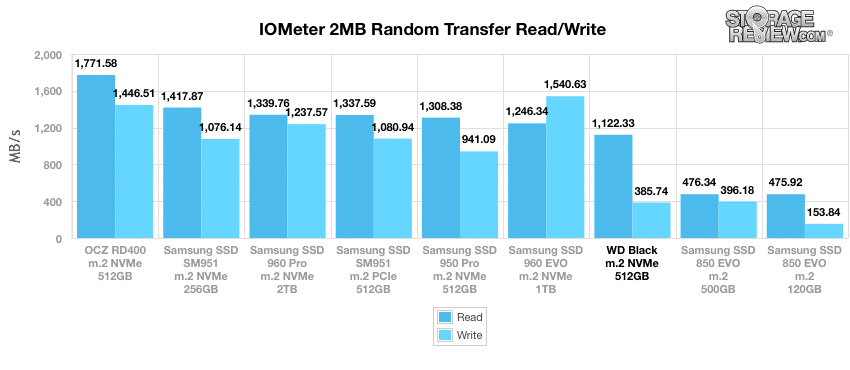
Our random 4k benchmark puts more strain on the drives in terms of throughput. The WD Black had transfers speeds of 29.28MB/s read and 54.73MB/s write. With read speeds the WD Black was third from the bottom beating out both the Samsung 960 EVO and the OCZ RD400. In write speeds it was dead last with the next closest drive, the Samsung 850 EVO, doubling its performance.
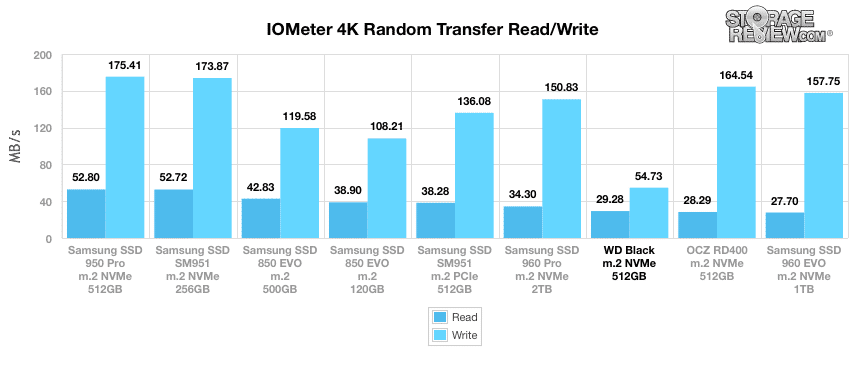
We also look at IOPS of the same random 4k benchmark. Again the WD Black was able to eek past the same two drives as above in read with a score of 7,495 IOPS. And it was in last place again with write performance scoring 14,011 IOPS.
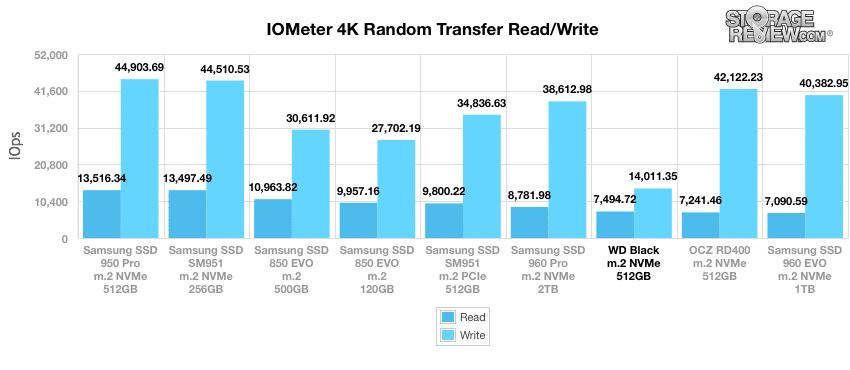
Looking at 4k latency, the WD Black had an average latency of 0.071ms, which in and of itself is not bad but it was much higher than the other drives tested. In max latency the WD Black performed much better, its best performance yet, with 0.22ms and second place.
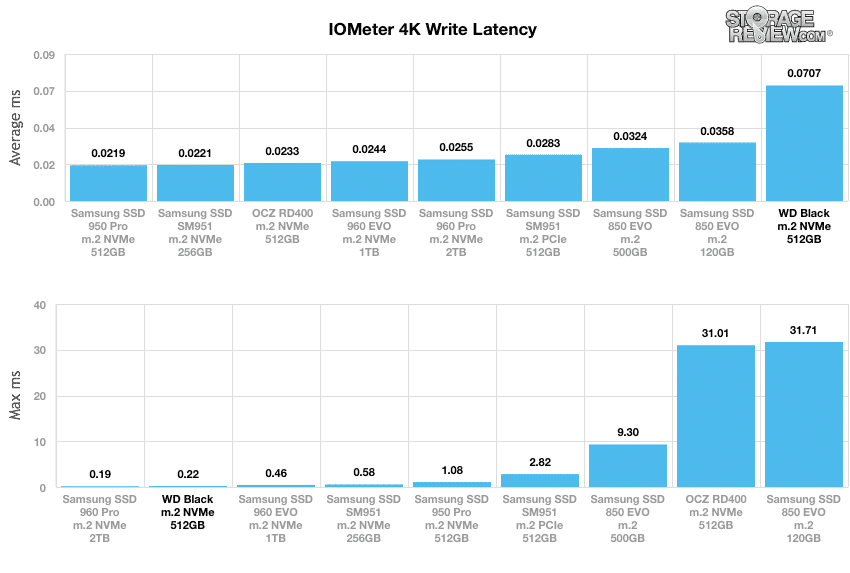
For our next 4K test, we move to a workload with 100% write activity, which scales from 1QD to 64QD. With Aligned write, the WD Black performed somewhat better landing roughly in the middle of the pack. The WD Black peaked at just over 94K IOPS before settling around 83K IOPS.
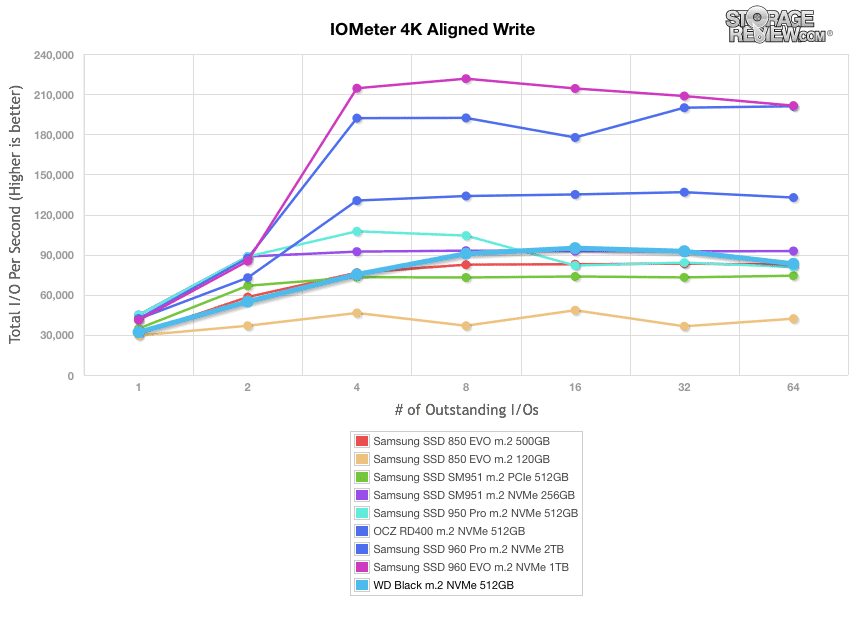
Aligned read showed similar placing for the WD Black, roughly the middle again, with a peak score of 166,530 IOPS.
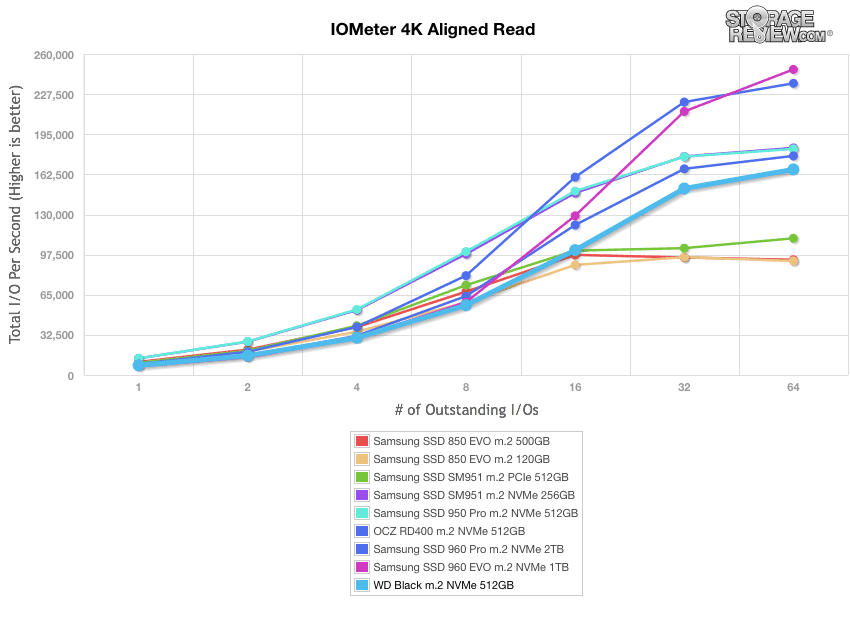
Our final consumer-synthetic benchmarks compare the drives in a series of mixed-server workloads with a queue depth of 1 to 128. Each server profile has a strong bias towards read activity, ranging from 67% read with the database profile to 100% read in the web server profile.
The database profile features a 67% read and 33% write workload, focusing on transfers around 8K in size. Here the WD Black came in second to last peaking at 40,584 IOPS.
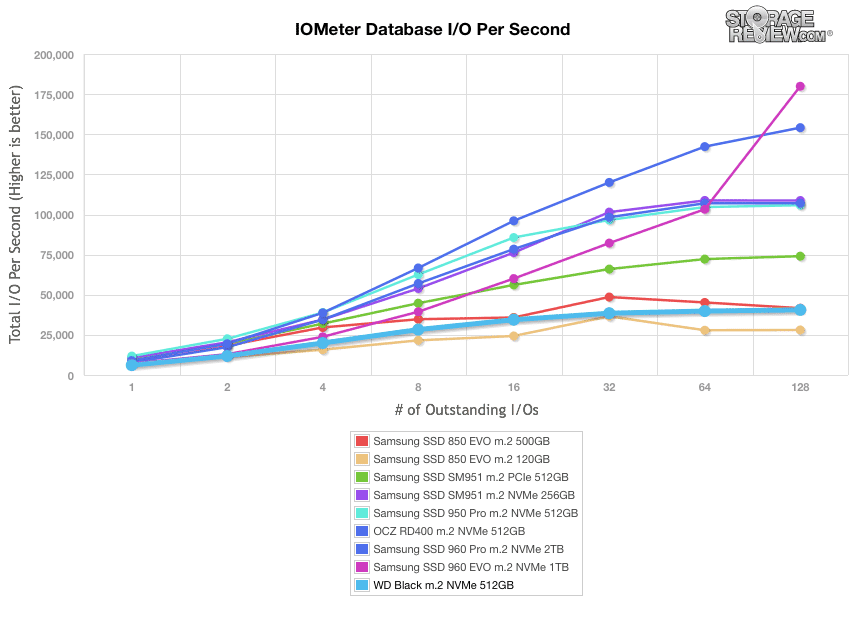
Our next benchmark is the read-only web-server profile, which uses transfer sizes ranging from 512 bytes to 512KB. In this scenario, the WD Black placed last with a peak just over 24K IOPS before settling in around 23.5K IOPS.
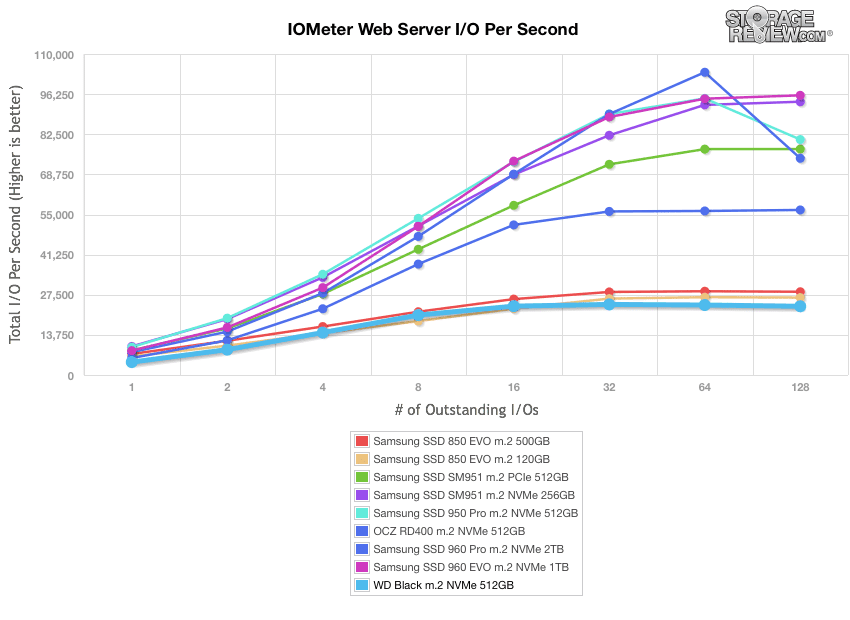
During the file-server profile, which has 80% read and 20% write workload spread out over multiple transfer sizes ranging from 512-bytes to 64KB, the WD Black ran second from last throughout most of the benchmark, running just above 128GB Samsung EVO SATA drive. Right at the end the EVO passed the Black, the WD Black having a score just over 30K IOPS and the EVO pressing on to just over 31K IOPS.
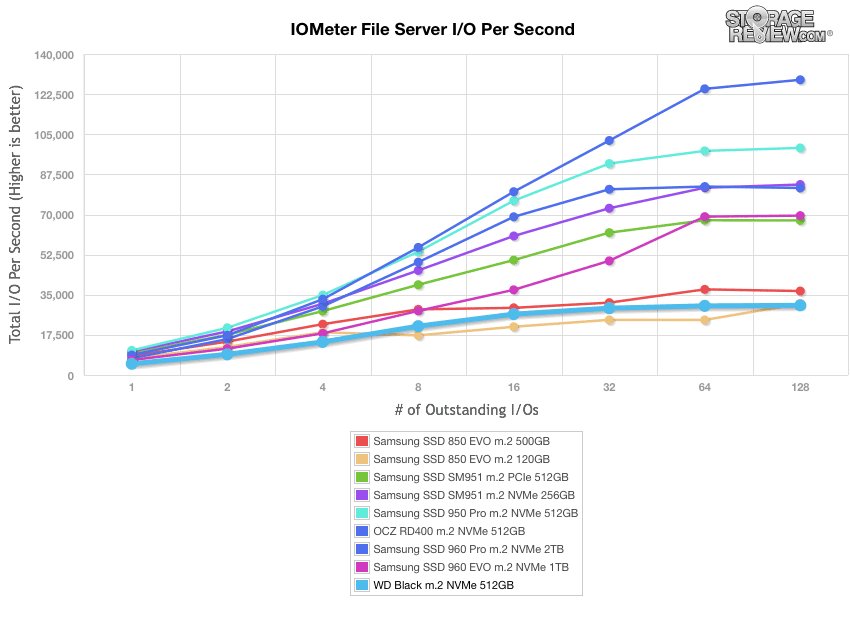
The last profile looks at workstation activity; with a 20% write and 80% read mixture using 8K transfers. We saw similar placement as the above test only as the 128GB EVO passed the WD Black, the 500GB EVO fell beneath it in performance, giving the WD Black second to last in performance by a hair.
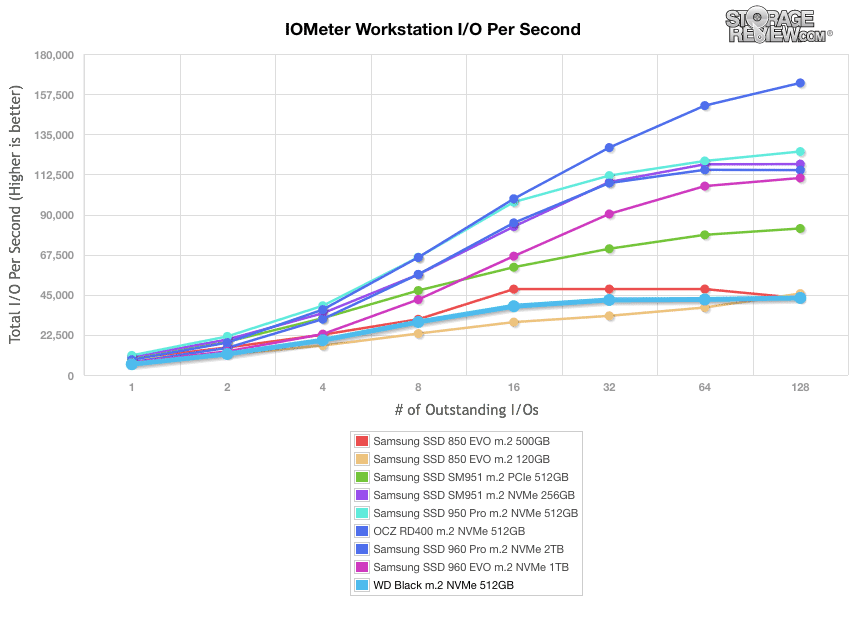
Consumer Real-World Benchmarks
While the results of synthetic benchmarks are important in identifying the key strengths and weaknesses of a drive, performance in these tests does not always translate directly into real-world situations. To get a better idea how the WD Black PCIe SSD will handle itself in the field, we will chart StorageMark 2010 HTPC, Productivity, and Gaming traces against comparable drives. Higher IOPS and MB/s rates with lower latency times are preferred.
The first trace is based on use as a Home Theater PC (HTPC). The test includes playing one 720P HD movie in Media Player Classic, one 480P SD movie playing in VLC, three movies downloading simultaneously through iTunes, and one 1080i HDTV stream being recorded through Windows Media Center over a 15-minute period.
Here we saw the WD Black outperform the SATA drives in IOPS with a score of 12,105 IOPS or 50% higher than the SATA drives. Similar was seen with both transfers speeds (the WD Black had 554.01MB/s) and latency (with the Black having 0.584ms). However, in all cases the other NVMe drives were well ahead of the WD Black.
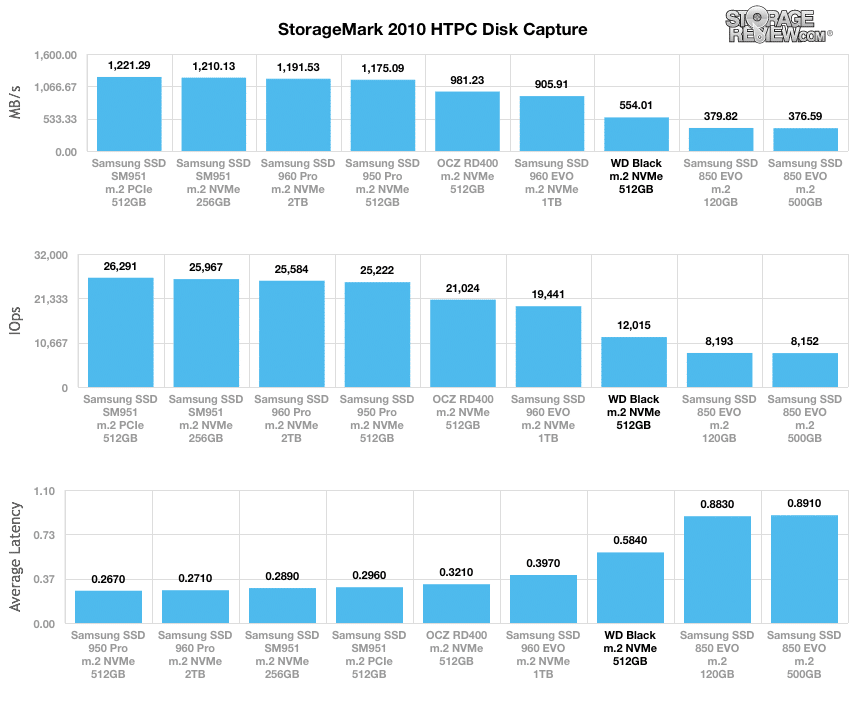
The next trace simulates disk activity in an office workstation or productivity scenario. This test includes three hours of operation in an office productivity environment with 32-bit Windows Vista running Outlook 2007 connected to an Exchange server, web browsing using Chrome and IE8, editing files within Office 2007, viewing PDFs in Adobe Reader, an hour of local music playback, and two hours of streaming music via Pandora.
In the productivity benchmark, the placement was similar to the above with the WD Black giving us performance of 8,921 IOPS, 260.67MB/s, and 0.862ms latency. Here, however, the 500GB SATA drive performed better than the Black across the board and the 128GB SATA was very close in terms of performance.
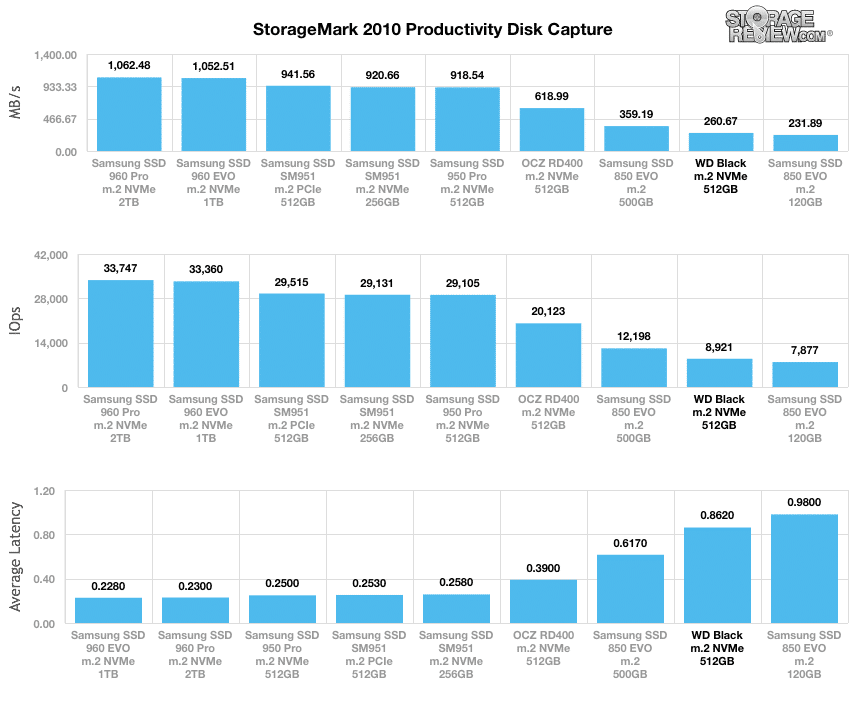
The final consumer real-life benchmark simulates disk activity during gaming. This simulation taxes the drive’s read performance, with 6% write operations and 94% read operations. The test consists of a Windows 7 Ultimate 64-bit system pre-configured with Steam, and with Grand Theft Auto 4, Left 4 Dead 2, and Mass Effect 2 already downloaded and installed. The trace captures the heavy read activity of each game loading from the start, as well as textures as the game progresses.
In our gaming benchmark, the WD Black did better here by beating out the SATA drives all across the board but were behind the other NVMe drives. The WD Black had scores of 16,414 IOPS, 822.25MB/s, and a latency of 0.462ms.
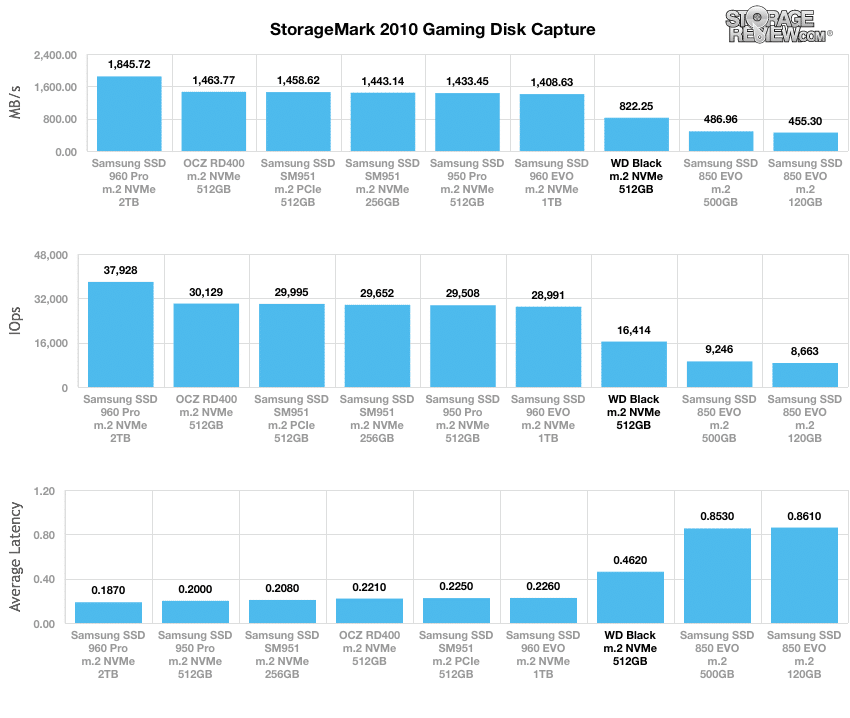
Conclusion
The WD Black PCIe SSD is the latest NVMe, M.2 drive to hit the market and the first under the WD banner. Like other NVMe drives before it, the WD Black PCIe SSD touts better performance with lower latency; although this time with better economics thanks to TLC NAND. Being an M.2 form factor brings about the benefits of taking higher performance and placing it in a smaller fashion making it appealing for ultra thin notebooks. The drive comes in two capacities 256GB and 512GB. To ensure that the drive is highly compatible, WD has certified it in its F.I.T. Lab. The drive comes with WD SSD Dashboard allowing users to monitor drive health and Acronis True Image for easy cloning.
Looking at performance, the WD Black PCIe SSD comes in far below our expectations, considering the historical branding the “Black” high-performance naming implies. In almost all cases the drive was behind all of the other NVMe drives and in several cases it lagged behind SATA-based models as well. To get an idea of how it performed, the WD Black PCIe SSD had scores of 1.51GB/s read ad 763.8MB/s write in our 2MB sequential benchmark, and 1.12GB/s read and 385.74MB/s write in our 2MB random. The only benchmark where the WD Black was able to get a leg up on the other NVMe drives was the random 4k beating out the Samsung 960 EVO and OCZ RD400 with 29.28MB/s read and 54.73MB/s write transfer speeds and 7,495 IOPS read and 14,011 IOPS write. In our Consumer Real-World Benchmarks the WD Black beat the SATA drives in HTPC and Gaming benchmarks but was passed up by the Samsung EVO 500GB SATA in our Productivity benchmark.
The WD Black PCIe SSD can be picked up for $110 for the 256GB model and $200 for the 512GB model. For $10 more, someone can pick up the Samsung 960 EVO 250GB model and see dramatically better performance. The 960 EVO 500GB is a bit more pricy at $250 ($50 more), but, again, packs much, much more of a performance punch. The performance of this drive strikes us as a bit odd, considering the WD owns both SanDisk and HGST, which have been known to bring industry-leading flash products to market in the past. The WD Black PCIe SSD struggles from both an identity and pricing crisis. At current levels it’s not worth considering, however should the Black be found on deep discount in the coming months, the value might rebalance and make it worth consideration.
Pros
- Good software bundle, warranty
Cons
- Poor performance in general across all benchmarks
- Priced too high compared to the performance it gives
The Bottom Line
The WD Black PCIe SSD is an M.2 NVMe drive that lacks both performance and competitive pricing in a highly competitive market.
Sign up for the StorageReview newsletter
